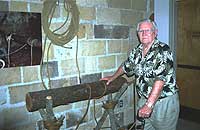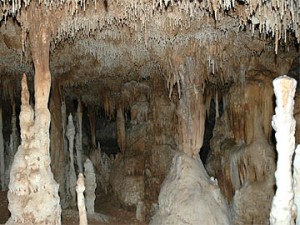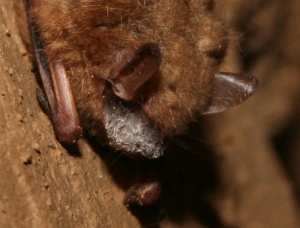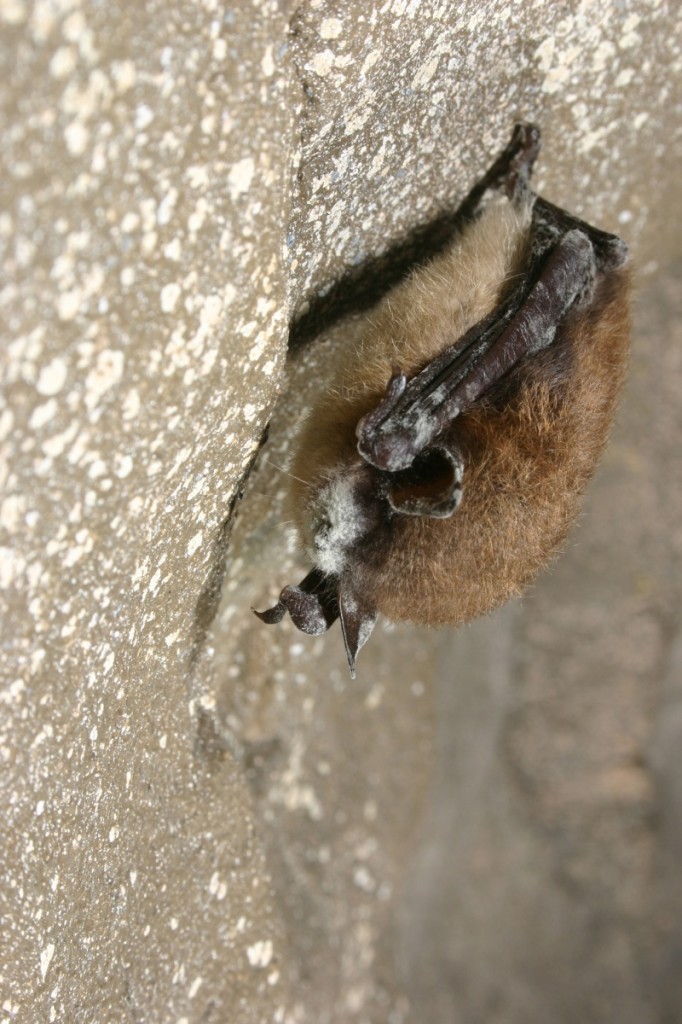Forty eight years have passed since cavers exploring the lower sections of Blanchard Springs Caverns made their way up a steep rocky wall and squeezed their way through a narrow opening. What they encountered was amazing, though dim lights made visible only a small sliver of their colossal discovery. They had entered what's now known as the upper, or Dripstone, level of the caverns, where the largest rooms and most spectacular formations are found!
The exploration team, which consisted of four Batesville natives, had made what’s been hailed as the most important cave discovery of the 20th century. Hail Bryant, who was accompanied by Mike Hill, Robert Handford and Hugh Shell (who died in 2002), said the find was kept a secret for several weeks because they didn't really know how extensive the chamber was.
"Our lighting allowed for very limited vision," Bryant recalled. "Until we rigged up a multi-flash camera system and later viewed the slides and photos, we had no idea that we had stumbled onto something very special."
 Shell, an ex-WWII Marine and a veteran cave explorer, learned about Half-Mile Cave in the mid-1950s. Then, the only way in and out of the extensive underground system was a 70-foot vertical shaft located about one-half mile from Blanchard Springs. Shell made his first attempt to descend the shaft in 1959 using a homemade rope ladder that proved to be too short. The failed venture, though, only increased his desire.
Shell, an ex-WWII Marine and a veteran cave explorer, learned about Half-Mile Cave in the mid-1950s. Then, the only way in and out of the extensive underground system was a 70-foot vertical shaft located about one-half mile from Blanchard Springs. Shell made his first attempt to descend the shaft in 1959 using a homemade rope ladder that proved to be too short. The failed venture, though, only increased his desire.
Bryant, who started exploring caves in his teens, teamed with Shell in 1960, and the two began working on a system to more easily descend and ascend the cavern's natural entrance. Soon the gear was ready and together they descended to the floor of the middle level of the cave. Once there they faced underground river crossings, muddy passageways, gigantic rocks and total darkness.
Shell and Bryant maintained a scientific approach, mapping and photographing miles of passages. Their findings were then turned over to the U.S. Forest Service, which owned Blanchard Springs because the caverns were part of the Ozark National Forest. At one time, Shell, Bryant and their teams were the only non-Forest Service personnel granted permission to enter the caverns.
Often the exploration team consisted of high school and college students. "But we always had a captain in charge of each trip," Bryant said. "Those young cavers deserve much of the credit, because they worked hard for the team."
The upper level of the caverns was almost discovered in 1960 and again in 1962. "We could see debris [gravel] that had washed from a small crevice at the top of a 60-foot wall of rocks," Bryant said. "Finally, in 1963, the team made it to the top and squeezed through to the upper level."
After leading several news photographers, writers and Forest Service officials through the Dripstone section, the caverns gained notoriety as others witnessed firsthand the extent of its remarkable discovery. But more work had to be done. So Bryant and his team prepared a presentation and traveled Arkansas and to Washington D.C. in an effort to convince the public and government officials that Blanchard Springs Caverns were unique.
"Using color slides and commentary, we had to assure people that caves like this are extremely rare, and something the public would want to visit," Bryant said.
An article printed in Life magazine in 1964 featured a full-color photo layout of Blanchard's spectacular formations and brought national attention to the cave. By the time the pictures appeared, plans were underway to develop a trail through the upper chambers. When Shell and Bryant ended their studies in 1964, they had photographed and mapped about 10 miles of passageways.
It took workers nearly 10 years to construct the Dripstone Trail. Great care was taken throughout, with much of the work done by hand to avoid damaging the underground environment. Low-level lighting and an air-lock door system were installed, and after 30 years of tours, they have helped keep Blanchard a "living" cave.
The Dripstone Trail and the visitors center complex opened to the public on July 7, 1973. During its first season, travelers from 48 states and 29 foreign countries toured the caverns. For the first time, visitors could enjoy intriguing features such as flowing draperies, multi-colored stalagmites and stalactites, sparkling columns up to 65 feet tall, and delicate coral-like calcite on the walls of the cave. And, for the first time, they could experience the enormity of the caverns -- the largest room is 180 feet wide and the length of four football fields placed end to end.
Almost immediately work started on a second tour, the Discovery Trail, which opened in 1977 and covers parts of the cave first explored. Visitors may view the natural stone shaft where the explorers descended by rope and one of the largest flowstones in the world -- some 140 feet long and 40 feet tall. Discovery is quite strenuous, with about 700 stairsteps. Designed for the physically fit, it is open only during the summer months.
Those who've visited the Dripstone have been able to experience the wonders Bryant and his team discovered with relative ease. A 216-foot elevator shaft has replaced the need for ropes at the sinkhole, and concrete pathways with handrails lead the way as Forest Service interpreters provide interesting facts about Blanchard, which is now ranked among the 10 most beautiful caverns in North America.
The latest Blanchard Springs Cavern tour debuted in the spring of 2000. "Wild Cave" tours are guided trips into undeveloped reaches of the cavern system. An immediate hit with the more adventurous, the wild cave experience requires that participants crawl up and down dirt slopes, squeeze through tight spots and scramble over large rocks. Those that take the wild cave tour, though, are rewarded with fantastic sights not seen on the first two tours. These tours are by reservation only.
While the Shell-Bryant team did most of the important job of exploring and recording their findings, they were not the first explorers in Blanchard Caverns. In 1934, Willard Hadley, a Forest Service planner, descended the natural entrance and conducted limited excursions. Then, in 1955, Roger Bottoms of West Helena lead a small team into the caverns several times. It was Bottoms who discovered the remains of a prehistoric Native American who died in the cave some 1,000 years ago.
Other facilities at Blanchard Springs Caverns include an exhibit hall, movie theater and bookstore. The Blanchard Springs Recreation Area offers scenic campsites, a fishing lake stocked with trout, hiking trails, picnic sites, limestone bluffs and the massive spring that emerges from the caverns.
Some 3.09 million persons have toured Blanchard Springs Caverns since 1973. Still, it is thought by many as "one of the best kept secrets in the Ozarks." Tour reservations are advised by calling 1-888-757-2246.
Explorers' Exhibit at Batesville Museum
An exhibit on display through Oct. 15 at the Old Independence Regional Museum in Batesville features much of the original equipment, supplies and cameras used to explore Blanchard Springs. In addition to many photos made during early cave excursions, "Exploring Blanchard Springs Caverns" includes a hand-drawn map of the underground chambers and the types of gear, safety equipment, clothing and food used when exploring the cave.
A portion of the original hickory log, used to lower and lift spelunkers in and out of the cave, is also displayed. And nearby, a mannequin fitted with authentic 1960 caving gear appears ready to climb into an automobile tire "saddle" for the descent into the cave. A slide-video program completes the story of exploring the caverns.
Explorers Hail Bryant, Jim Buchanan, Charlie Rogers, Billy Sneed, Lester McGuffey and Mike Hill were on hand for the Aug. 2 opening of the exhibit.
"Exploring Blanchard Springs Caverns" is open from 9 a.m. to 4:30 p.m. Tuesday through Saturday and from 1:30 to 4 p.m. Sundays. A small admission is charged. For more information, contact the museum at (870) 793-2121 or visit www.oirm.org.
By Craig Ogilvie, travel writer
Arkansas Department of Parks & Tourism




